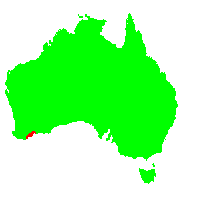General Description:
Eucalyptus newbeyi is one of several similar eucalypts, the best known of which is Eucalyptus conferruminata, which is widely cultivated (but under the misapplied name of Eucalyptus lehmannii, a different species).
Eucalyptus newbeyi is a small tree to about 8-10 metres tall, often of mallee habit, with lance-shaped leaves to about 100 mm long. This and the other four related species have very unusual, long, finger-like bud caps (opercula) to about 40 mm long. In E.newbeyi, these are smooth and the flower buds are not fused at the base. The buds occur in clusters of 3 to 9 at the end of a flattened, curved stalk. The buds open to reveal large, yellow flowers about 40 mm in diameter in spring.
E.newbeyi is a very attractive tree for cultivation due to its moderate size and very conspicuous and colourful flowers. As a species native to relatively dry areas, E.newbeyi is best suited to cultivation in climates which have a dry summer. However, it is more adaptable to the more humid conditions of eastern Australia than many other species from the west and is certainly worth a try in most temperate climates. It is tolerant of extended dry conditions once established and is also tolerant of at least moderate frosts.
Propagation is from seed which germinates readily.
* EPBC Act = Environment Protection and Biodiversity Conservation Act 1999;
ROTAP = Rare or Threatened Australian Plants (Briggs and Leigh, 1988)
For further information refer the Australian Plants at Risk page

Flowers of Eucalyptus newbeyi
Photo: Ron Powers

Elongated bud caps of Eucalyptus newbeyi
Photo: Ron Powers
 Australian Native Plants Society (Australia)
Australian Native Plants Society (Australia)













